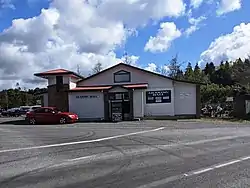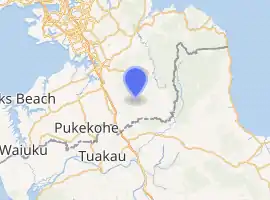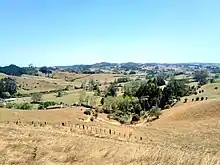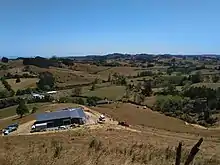Ararimu
Ararimu is a locality in Auckland, New Zealand. It is in the Franklin Ward of Auckland Council.
Ararimu | |
|---|---|
 Ararimu community hall | |

| |
| Coordinates: 37.140°S 175.038°E | |
| Country | |
| Region | Auckland Region |
| Territorial authority | Auckland Council |
| Ward | Franklin Ward |
| Board | Franklin Local Board |
| Population (2018)[1] | |
| • Total | 2,124 |

History
At the time of European settlement, Ararimu was densely covered with native trees.[2] A dispute over rights to take kauri gum was settled in 1857 in favour of Ngāti Whātua.[3] The land was taken by the government under the New Zealand Settlements Act of 1863 and divided into blocks of about 280 hectares (700 acres).[4] Lots were auctioned in 1867, and three pioneers made purchases: J Dunn, Laughlan Keaney and John Markham.[5] These three families remained in Ararimu for many decades, with the last descendents of the Dunn family leaving in 1985.[2]
In 1871, residents petitioned for roads to improve access to their farms.[6] £100 was allocated to the building of a road between Ararimu and Maketu (Ramarama) at the end of 1873.[7][8] and the road was built using volunteer labour the following year.[2] About ten years later, the road was metalled. This road, now called Pratts Road, was steep and twisting but gradually improved with cuttings and deviations. It is still gravel as of 2020. The present Ararimu Road replaced it in 1925 and was much easier to travel on,[9] although it was not sealed until the 1970s. Totara Road was formed after 1933 and gave access to Bombay.[10] Gelling Road connected Ararimu to Hunua after the Second World War, but it remained gravel at least into the 1980s.[11]
A dispute between neighbours escalated into murder in December 1876, with Martin Curtin killing Denis Shanaghan.[12] It seems likely that Curtin was mentally ill. His trial started only five days later, and he was found guilty and sentenced to death. He was hanged the following February.[13][14]
The New Zealand Dairy Association operated a creamery from 1892 to 1917.[15][16] This had the effect of increased wear on the roads as individual farmers took their produce to the creamery when previously a single wagon collected the produce to take to Auckland. Home separation of cream was used after 1917.[17]
Although a post office operated from several individuals houses earlier, the first official Post Office opened at Ararimu in 1888.[18] It closed about 1931, with rural delivery taking its place. A telephone and telegraph office opened in 1891,[19] but about 1928 it was replaced by telephones installed in individual homes.[20] In 1928 or 1929, electricity was supplied to the area for the first time.[21][22]
A local newspaper, The Ararimu Courier, was produced from 1962, consisting at first of one or two sheets run off on a Gestetner at the school, and produced twice a month. The circulation reached 50 in the early 1970s, and the number of pages increased. About 1990 the production changed to photocopying, and from 2001, it was professionally printed in Manukau. The circulation reached 210 by 2016.[23]
Lifestyle blocks first appeared at Ararimu in the mid-1970s. By 2016, they were the most common form of land use. The blocks increased the tree and bush cover of the area, resulting in an increase of bird life and reduction of erosion.[24]
The Auckland Regional Authority proposed in 1986 to build a dam on the Mangawheau Stream to supply water for Auckland. The dam would have created a lake of 130 hectares in the Sinclair Road area which would have affected about 100 farms. Residents held a public meeting and formed an action group called Riverwatch to lobby against the dam. While the group could not convince the ARA against the dam, a water conservation campaign in the city reduced the need for a new water supply, and in 2002 a pipeline from the Waikato River solved the problem until 2020.[25]
Demographics
| Year | Pop. | ±% p.a. |
|---|---|---|
| 2006 | 1,689 | — |
| 2013 | 1,836 | +1.20% |
| 2018 | 2,124 | +2.96% |
| Source: [1] | ||
The statistical area of Ararimu, which at 91 square kilometres is much larger than the locality, had a population of 2,124 at the 2018 New Zealand census, an increase of 288 people (15.7%) since the 2013 census, and an increase of 435 people (25.8%) since the 2006 census. There were 675 households. There were 1,077 males and 1,044 females, giving a sex ratio of 1.03 males per female. The median age was 42.1 years, with 486 people (22.9%) aged under 15 years, 279 (13.1%) aged 15 to 29, 1,137 (53.5%) aged 30 to 64, and 222 (10.5%) aged 65 or older.
Ethnicities were 93.2% European/Pākehā, 8.1% Māori, 2.0% Pacific peoples, 2.8% Asian, and 2.1% other ethnicities (totals add to more than 100% since people could identify with multiple ethnicities).
The proportion of people born overseas was 20.9%, compared with 27.1% nationally.
Although some people objected to giving their religion, 56.5% had no religion, 32.1% were Christian, 0.7% were Hindu, 0.3% were Muslim, 0.0% were Buddhist and 2.3% had other religions.
Of those at least 15 years old, 366 (22.3%) people had a bachelor or higher degree, and 219 (13.4%) people had no formal qualifications. The median income was $48,600. The employment status of those at least 15 was that 1,020 (62.3%) people were employed full-time, 237 (14.5%) were part-time, and 33 (2.0%) were unemployed.[1]
Education

Ararimu School is a full primary school (years 1–8) with a roll of 133.[26] The school website says it was established in 1867,[27] but this may be a misprint, as a request was made for a school at Ararimu in 1874,[28] and the school celebrated its centenary in 1983.[29]
There were classes held at a Catholic chapel in 1975 or 1876, and later at the Lynch Home.[30][31] The Valley School was built in 1876 on donated land with costs and labour met by the community.[32] To serve the population of the upper Ararimu valley, a second school opened in 1883, but the original school closed in 1890.[33][34][35] There was some ill-feeling in the community about this closure, and some families sent their children to Paparata School, even though Upper Ararimu School was closer.[36][37] Upper Ararimu school dropped from two teachers to one in the early twentieth century, and shared a teacher on occasions with either Paparimu or Hunua South schools.[36][38] After a community meeting in 1920, where upper valley residents were late to arrive, a motion was passed to move the school back to the middle valley. The school was moved piece-by-piece in 1922.[39][38]
The school acquired a swimming pool in 1954. Prior to this, swimming was taught at a pool formed by a dam on Dunn's Creek just up the road. The pool was replaced in 1985.[40]
The school building was used for public meetings, dances and socials until Ararimu Hall was built across the road in 1957.[39][41] The building was divided into two classrooms by a curtain, and later by a wooden partition. In 1964 a second building was added, and the partition removed.[42] The original building was replaced in 1981, and new classrooms were added, with nine classrooms operating in 2017.[43]
Paparimu School is a full primary school (years 1–8) with a roll of 28.[44] It opened in 1899.[45] Paparimu School is about 8 km east of Ararimu School.
Both schools are coeducational. Rolls are as of March 2020.[46]
References
- "Statistical area 1 dataset for 2018 Census". Statistics New Zealand. March 2020. Ararimu (166400). 2018 Census place summary: Ararimu
- Reid, Toni (October 2015). "The early days in Ararimu".
- "Province of Auckland - Manukau District - Kakaramea Block". Maori Messenger : Te Karere Maori. 31 October 1857. p. 2.
- "The Waikato Lands". The New Zealand Herald. 13 February 1866. p. 4.
- "Government Land Sale". Daily Southern Cross. 22 January 1867. p. 4.
- "Provincial Council - Petitions". Daily Southern Cross. 22 December 1871. p. 3.
- "Provincial Council - This Day". Auckland Star. 19 December 1873. p. 2.
- "Special Telegrams to the "Waikato Times"". Waikato Times. 20 December 1873. p. 2.
- "The Valley of Ararimu". The New Zealand Herald. 26 December 1925. p. 1 (supplement).
- "Lower County Rates". The New Zealand Herald. 20 July 1933. p. 12.
- Reid 2017, pp. 184-189.
- "The Murder Near Papakura". New Zealand Herald. 19 December 1876. p. 2.
- Reid 2017, pp. 132-139.
- "Execution of Martin Curtin". Auckland Star. 6 February 1877. p. 2.
- "Country News - Ararimu South". New Zealand Herald. 25 August 1892. p. 6.
- "Ararimu - The Dairying Industry". Pukekohe & Waiuku Times. 26 June 1917. p. 2.
- Reid 2017, pp. 144-5, 151, 165.
- "Chief Post Office". Auckland Star. 5 November 1888. p. 8.
- "Untitled". New Zealand Herald. 10 April 1891. p. 4.
- Reid 2017, pp. 242-4.
- "Electricity in Franklin Area". Franklin Times. 7 November 1928. p. 5.
- "Electricity - The Work in Franklin". Franklin Times. 27 November 1929. p. 5.
- Reid 2017, pp. 444-447.
- Reid 2017, pp. 159, 161.
- Reid 2017, pp. 448-451.
- Education Counts: Ararimu School
- "Our Charter". Ararimu School. Retrieved 27 September 2020.
- "Board of Education - Maketu". The New Zealand Herald. 3 July 1874. p. 3.
- The Valley school : a history of Ararimu School, 1883-1983. Ararimu Centennial School Committee, 1983. 1983.
- Milne 1983, p. 3.
- Reid 2017, p. 211.
- McDonald 1967, pp. 35-36.
- Milne 1983, p. 4.
- Reid 2017, pp. 213-215.
- McDonald 1967, pp. 37-40.
- Milne 1983, p. 6.
- Reid 2017, p. 214.
- Reid 2017, p. 216.
- Milne 1983, p. 9.
- Reid 2017, pp. 217-218,222.
- Reid 2017, p. 217.
- McDonald 1967, pp. 42-43.
- Reid 2017, pp. 221-222, 227.
- Education Counts: Paparimu School
- "Our School". Pararimu School. Retrieved 27 September 2020.
- "New Zealand Schools Directory". New Zealand Ministry of Education. Retrieved 26 April 2020.
Print sources
- McDonald, George, ed. (1967). They Chose This Valley: Ararimu Centennial 1867–1967. Ararimu Centennial Committee.
- Milne, J. (1983). The Valley School: A History of Ararimu School 1883–1983. Ararimu Centennial School Committee.
- Reid, Toni, ed. (2017). Our Path through the Rimu: a history of the Ararimu community 1867-2017. Ararimu Residents & Ratepayers Association Inc. ISBN 9780473385613.